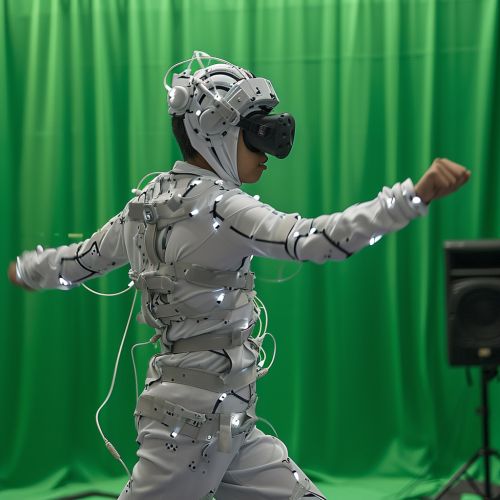Motion capture
Overview
Motion capture, also known as mocap, is a technology that digitally records and analyzes human movement. This technology is used in a variety of fields, including entertainment, sports, and medical applications. The process involves recording actions of human actors and using that information to animate digital character models in 2D or 3D computer animation. Computer animation is a digital successor to stop motion techniques using 3D models, and traditional animation techniques using frame-by-frame animation of 2D illustrations.

History
The concept of motion capture technology originated in the late 19th century with the invention of the chronophotographic gun, a device that could take multiple photographs of a moving object. This was the first step towards capturing movement for analysis and it paved the way for the development of modern motion capture technology. The first use of motion capture for entertainment purposes was in the 1970s, when it was used to create a digital character for the film "Futureworld". Since then, the technology has been used in a wide range of films, video games, and other forms of entertainment.
Technology
Motion capture technology works by recording the movement of objects or people. It does this by attaching markers to the subject, which are then tracked by cameras. The data from these markers is then used to create a 3D representation of the subject's movement. There are several types of motion capture technology, including optical, inertial, and magnetic systems. Each of these systems has its own advantages and disadvantages, and the choice of system depends on the specific requirements of the project.
Optical Systems
Optical systems use cameras to track markers attached to the subject. These markers can either be passive, reflecting light back to the cameras, or active, emitting their own light. The cameras then record the position of the markers, and this data is used to create a 3D representation of the subject's movement.
Inertial Systems
Inertial systems use sensors attached to the subject to measure acceleration and rotation. This data is then used to calculate the subject's movement. One advantage of inertial systems is that they do not require a dedicated capture space, as they do not rely on cameras to track markers. However, they can be less accurate than optical systems, particularly over longer periods of time.
Magnetic Systems
Magnetic systems use sensors that measure the magnetic field created by a transmitter. The sensors are attached to the subject, and the transmitter is placed in the capture space. The sensors then measure the strength and direction of the magnetic field, which is used to calculate the position and orientation of the subject. Magnetic systems can be very accurate, but they can also be affected by other magnetic fields, such as those created by electrical equipment.
Applications
Motion capture technology has a wide range of applications, from entertainment to sports to medicine.
Entertainment
In the entertainment industry, motion capture is used to create realistic animations for films, video games, and virtual reality experiences. It allows animators to create more realistic and nuanced animations than would be possible using traditional animation techniques. Some notable examples of films that have used motion capture include "Avatar", "The Lord of the Rings", and "The Polar Express".
Sports
In sports, motion capture is used to analyze athletes' performance, to help improve technique and prevent injuries. It can also be used to create realistic animations for sports video games.
Medicine
In medicine, motion capture is used to analyze patients' movement for diagnostic and treatment purposes. It can be used to study the movement of patients with conditions such as Parkinson's disease, cerebral palsy, and stroke. It can also be used in the design and testing of prosthetic limbs.
Future Developments
The future of motion capture technology is likely to see further improvements in accuracy and ease of use. There is also potential for the technology to become more accessible and affordable, opening up new possibilities for its use. One area of potential growth is in the field of virtual reality, where motion capture can be used to create more immersive experiences. Another area is in the field of sports, where the technology could be used to provide more detailed analysis of athletes' performance.
